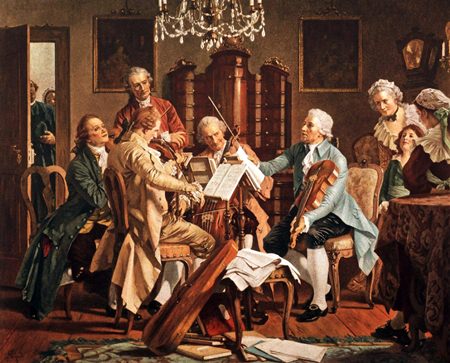
The other night, having nothing much to do, I was looking through the orchestral score of Tchaikovsky’s Sixth Symphony – his last one. He died only nine days after its first performance and the end of the symphony too literally fades away to complete silence. The last eight measures are scored for muted cellos and basses playing a low chord of B minor, so quiet that it’s barely audible. Then in the last measure of the symphony, Tchaikovsky writes a rest sign – the musical sign for silence, with a pause mark over the top, thus effectively writing in several moments’ complete silence at the end of the work.
In his Fifth Symphony, Tchaikovsky used silence dramatically in the last movement at a moment when the entire orchestra builds to a thundering climax. There are a few seconds of silence before the heroic closing section begins. It’s a moment of high drama because of the extraordinary sense of tension and anticipation that it creates. The silence is not just “nothing” but an integral part of the musical experience.
At its simplest level, silence marks the beginning and end of the music. It also occurs briefly between musical phrases, so that we can hear where one phrase ends and another one begins. Just think of Gregorian chant, and those periods of silence occur between the long flowing phrases. Beethoven often used silence for musical effect and during the early years of the twentieth century so did composers like Schoenberg and Webern. In some of Webern’s music there is probably more silence than there are notes. In contrast, in one of his string quartets Joseph Haydn used silence for a different reason: to raise a laugh.
In the late summer of 1781, Haydn wrote a set of six string quartets (classified as Op. 33) for the Viennese publisher Artaria, then one of the top publishing houses in Europe. Haydn was forty-nine and at the peak of his career.
Like his symphonies, many of Haydn’s quartets have acquired nicknames, largely because he wrote so many. In this one, known as “The Joke”, Haydn used silence in the last movement to create several false endings, so that the audience would applaud in the wrong places. It must have been tremendous fun at the first performance.
The performance by the brilliant Israeli Ariel Quartet is exceptional, partly because in their customary manner they perform the entire work from memory. It’s in the usual four movements, and like some other Op. 33 quartets, Haydn places the scherzo immediately after the first movement. This scherzo a very minuet-like affair, and is actually an Austrian peasant dance known as a Schuhplattler. In both this movement and the following slow movement, Haydn frequently uses silence to create tension.
The last movement (which begins at 13:55) takes the form of a lively Italian folk dance called the Tarantella. The first false ending is at 16:23; another one at 16.45 and another one at 16.50 which really sounds like the end of the piece. The real ending arrives at 17.00 but even in this video, the audience seems unsure whether or not to applaud. After two hundred years, you’d have thought that Haydn’s joke might have worn a bit thin but as this performance shows, it still seems to work.
John Cage (1912-1992): 4’33″ (Four minutes, thirty-three seconds) Berlin Philharmonic Orchestra, cond. Kiril Petrenko. (Video: 1080+ HD)
John Cage, once the enfant terrible of American contemporary music, took the notion of silence in music to the obvious limits when he created a piece consisting entirely of silence. Strangely enough, the idea was not entirely new. This three-movement work (if such it can be called) dates from 1952 and consists of virtually blank pages.
The total length of the three movements is supposed to be four minutes and thirty three seconds and it can be played by any instrument or combination of instruments. Cage always insisted that the piece was not a joke and it has even attracted serious academic debate. Of course, it can only work in the formalized concert performance setting at which the audience is expected to behave appropriately and demonstrate correct concert etiquette by sitting quietly and listening. The point of the whole exercise is that silence doesn’t actually exist and it draws attention instead to ambient sounds inside and outside the concert hall.
The Berlin Philharmonic gives a fine performance of this technically challenging work. The dynamics are beautifully measured, especially in the pianissimo sections and there’s an elegant sense of phrasing. Conductor Kiril Petrenko brings a rare insight into this remarkable work and creates a wonderful sense of expansiveness. You’ll probably want to listen to it several times.
 |
 |
 |





